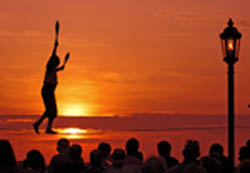In this June 2004 file photo, provided by the Florida Keys News Bureau, busker Will Soto walks a tightrope at the sunset celebration in Key West, Fla. The sunset celebration at Mallory Square is a daily ritual for visitors to this subtropical island at the bottom of the Florida Keys island chain. (AP Photo/Florida Keys News Bureau, Bob Krist) **NO SALES**

